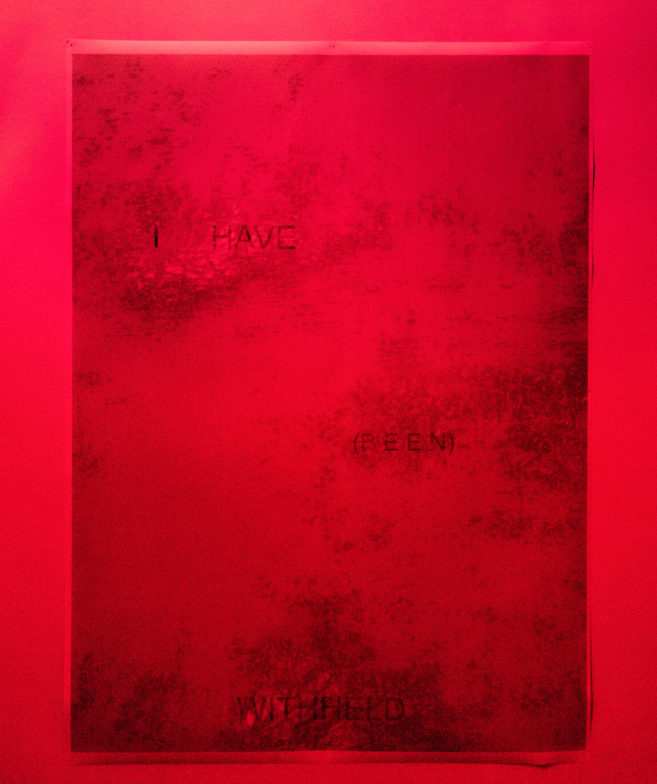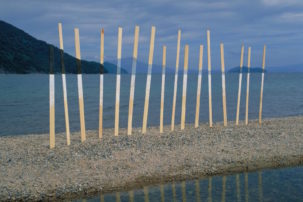In June 2016, while I was working as the associate director of adult programming at the Art Gallery of Ontario (AGO), I was asked to interview Stephan Jost, the gallery’s director and CEO, live on stage. Jost had arrived at the AGO from the Honolulu Museum of Art two months prior, and the event was to serve as a public introduction for the gallery’s members and audiences. About halfway through our hour-long conversation, I referred to a study published in Canadian Art the year prior that surveyed solo exhibitions over the preceding two years at Canada’s leading art museums, breaking down the demographics of the artists who had received exhibitions by gender and whiteness. Jost, reflecting on the AGO’s results (75 per cent male, 85 per cent white), said that this was an “active conversation” he was having with the curatorial team and that “you should hold me accountable publicly if I don’t [change] it within four years.”
Four years later, there is ample evidence of change in the AGO’s exhibition program. Of the 21 solo presentations mounted by the gallery over the past two years, just three exhibitions featured white men. Fifteen, or 71 per cent, focused on women artists, including Inuit artists Kenojuak Ashevak and Janet Kigusiuq, Black artists Sandra Brewster, June Clark, Mickalene Thomas and Winsom, and Anishinaabe artist Rebecca Belmore. This is material progress, even when one considers that Wanda Nanibush, the AGO’s visionary and intensely prolific curator of Indigenous art, helmed four of those seven exhibitions and invited the renowned academic and curator Andrea Fatona to guest curate a fifth.
But what this outward-facing progress obscures—and what I failed to ask Jost about back in 2016—goes beyond questions of representation within exhibitions, collections and education programs and into the circles where power is held, at the very centre of our public museums. As vital as curators and artists are to the ecology of the art museum, they are not the people who are ultimately in charge. It is at the senior executive and board level where policies are written, strategies determined, budgets set, conflicts judged, programs approved and key decisions ultimately made. And inside Canada’s leading art museums, those inner circles of power remain overwhelmingly white.
Over the past two weeks, I surveyed Canada’s four largest public art museums—measured by attendance and operating budget, these are the Montreal Museum of Fine Arts (MMFA), the AGO, the National Gallery of Canada (NGC) and the Vancouver Art Gallery (VAG)—to determine who sits on their boards of trustees and senior executive teams. (Senior executives are defined, for this purpose, as the staff members with the most senior positions who report directly to the director or CEO.) This is what I learned:
- The directors of all four museums are white.
- The board presidents of all four museums are white.
- Of the 24 senior executives across all four museums, 23 (or 96%) are white.
- Of the 77 board trustees across all four museums, 58 (or 75%) are white.
- Of those 77 trustees, 3 (or 4%) are First Nations or Métis, 2 (or 2.5%) are Black and 14 (or 18%) are other persons of colour; none are Inuit.
- The AGO has no Indigenous representation on its board.
- The MMFA, the VAG and the NGC have no Black representation on their boards.
The MMFA and VAG each confirmed the data above. The AGO confirmed that their senior executive team is all white and that their board comprises 19 white and 7 POC trustees, but would not delineate between Black, Indigenous or persons of colour among their trustees. The NGC, citing the Privacy Act, would not confirm the racial identifications of either their senior team or board of trustees, although they did share the results of a 2018 Employment Equity Report, which determined that 86.6 per cent of NGC staff were, at that time, white. Multiple sources inside the AGO and NGC, including trustees of both organizations, confirmed the data as reported.
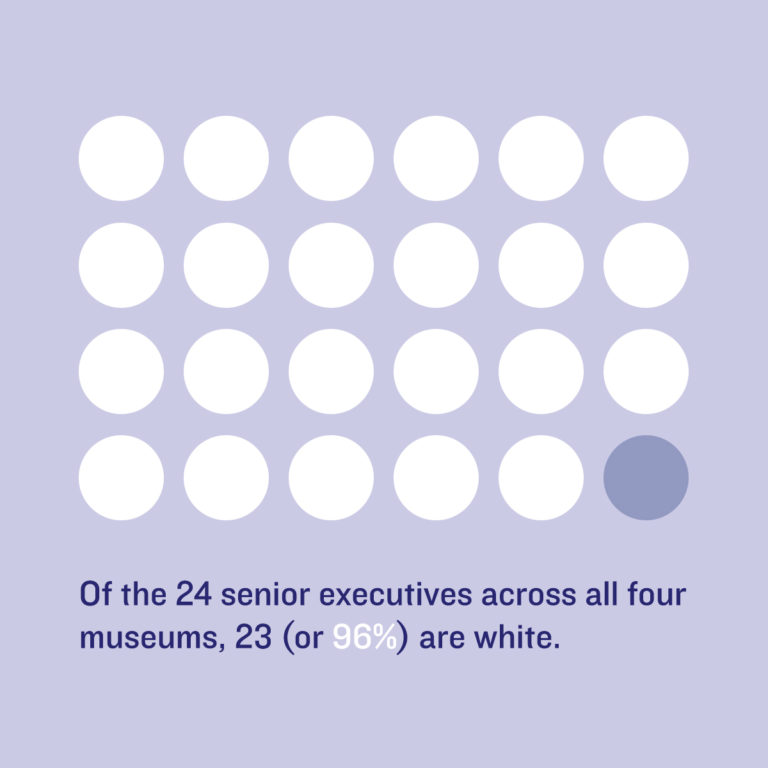
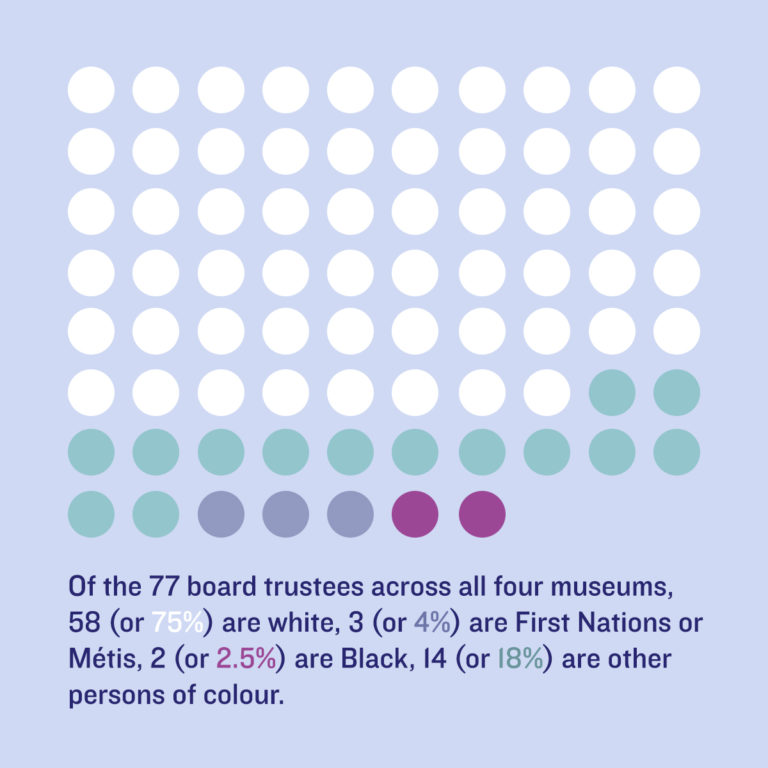
I reached out to the directors of each of the four museums for comment about what this data reveals, especially in light of the anti-Black racism solidarity statements recently issued by each organization.
Nathalie Bondil, director general and chief curator of the MMFA, has appointed or promoted each of the four members of the museum’s all-white senior executive team. She acknowledged that the museum’s efforts to diversify the exhibition program, collections and board of trustees—which remains 80 per cent white—have come before a focus on staff. She said, “In five years, I expect the picture will look completely different,” and noted that she is currently in the process of hiring a chief curator.
Daina Augaitis, who became interim director of the VAG last May after more than 20 years as chief curator, has appointed one permanent member to the gallery’s all-white senior leadership team, and said, “Are those numbers acceptable? No.” She noted that her team is beginning twice-weekly meetings dedicated to “discussions of cultural equity,” and said, “We’re a product of our history. These are colonial institutions. There needs to be a lot of work done to recognize that, to see what the biases are, and to really actively engage our audiences. Museums have started doing that work, but clearly the work hasn’t landed within the people who are hired to do those [most senior] jobs.”
Sasha Suda, director and CEO of the NGC, who joined the organization in April 2019 and has appointed or promoted three white executives to her senior team, said that this moment has led the gallery to begin conversations among staff and stakeholders about “what it means specifically to be an anti-racist institution.” She said, “We’re not serving all Canadians equally right now. We can’t find ourselves in this space and wonder how we got here. We have to name and find the source of the symptom and make sure this doesn’t keep happening.” She continued, “Some people who are really comfortable in this space with us, and have been for decades, might feel uncomfortable for a while, and I’m talking about audiences, stakeholders and staff alike.”
Since joining the AGO as director and CEO in 2016, Stephan Jost has appointed or promoted six white executives to his 10-person, all-white leadership team, although one of these appointments, Heidi Reitmaier, was let go in a restructuring on June 10, 2020. AGO representatives did not reply to multiple requests for Jost to be interviewed or provide a statement in response to this report. However, during our conversation back in 2016, Jost described his approach to diversifying the institution as one of “relentless incrementalism,” and said that his trajectory for the AGO’s staff, board, membership and audience to reflect Toronto’s diversity was “a 25-year goal.” He continued, “Simultaneously, I think that we need to really make sure we’re focusing on excellence. This isn’t just about inclusion. Inclusion is part of that conversation, but it doesn’t do anybody a service to lower standards or change standards, basically, to reach that goal.”
That statement, a veritable rich text of implicit bias, suggests that the inclusion of racialized voices risks diluting a standard of excellence which has been, since the inception of these institutions, fluid with whiteness. It is doubly troubling when one considers the ways that the biases of our institutions’ leaders inevitably become the biases of the institutions themselves. This is why changing the standards is exactly what’s required.
There’s no way around it: white-dominated leadership is unethical and irresponsible. It’s a standard that must change now if our public art museums have any hope of reckoning with the colonial violence of their histories
There’s no way around it: white-dominated leadership is unethical and irresponsible. It’s a standard that must change now if our public art museums have any hope of reckoning with the colonial violence of their histories to meet the plurality of their communities, the complexities of the present and the uncertainties of the future on a warming planet. The resources these museums hold—which are in large part provided by and for us, the public—are too rich to be hoarded. Among the many tragedies of their pervasive whiteness is the dampening of potential for art museums to become vital, responsive civic spaces where people can come together across difference to think and feel their way into life, surrounded by offerings of beauty and criticality and deep mystery, and supported by staff, programs and policies that embody representative and mutually accountable organizational design. Instead, too many people are left to wonder why and for whom these places exist; I’ve heard many artists, critics and community leaders question whether they shouldn’t just be left to the same past that many of their leaders cling to so tightly.
But the most dangerous outcome of this all-white leadership is not irrelevance; it’s the reflexive perpetuation of violence and harm toward the people they marginalize—Black people, Indigenous people, people of colour, people with disabilities, 2SLGBTQIA+ people—which has impacted the health and creative capacity of countless artists, staff and future leaders whose bodies don’t reflect whiteness back to itself. Museum leaders are often eager to trumpet their inclusive programming, but when conflict arises internally over harmful policies and practices, the arbiters are the ones who set the rules in the first place and directly benefit from maintaining the status quo: the whites at the top. As a cisgender, non-disabled, queer white man, I watched this dynamic play out at the AGO countless times over the course of my decade there, at times with a complicity that shames me today. And as report after report after report has pointed out, this toxic dynamic isn’t contained to Canada’s four largest art museums; it is endemic to the field.
It’s also why so many of the recent social media solidarity statements from art museums across North America have been met with deep eyerolls and vociferous comments from audiences, artists and staff alike. After reading the Guggenheim’s statement, curator Chaédria LaBouvier, the first Black person to curate an exhibition at the New York museum in its 80-year history—2019’s “Basquiat’s ‘Defacement’: The Untold Story”—described her time working at the museum as “the most racist professional experience of my life,” calling out the Guggenheim’s leadership and artistic director and chief curator Nancy Spector specifically for hostile, racist acts.
In Canada, the social media account Arts Accountability formed recently, with the mission to “[hold] Canadian arts organizations accountable to their #BlackLivesMatter statements,” and many prominent voices across the country’s culture sector are demanding institutional accountability. The CBC’s Amanda Parris wrote a crucial in-depth account of anti-Black racism across Canadian cultural institutions; Devyani Saltzman, the writer and curator who succeeded me as the AGO’s director of public programming, wrote a powerful essay about the “internalized mental subjugation” experienced by BIPOC leaders inside Canadian cultural institutions; Rea McNamara, the former programs manager at the Gardiner Museum, wrote an open letter to the museum’s leadership decrying the museum’s “ongoing exclusionary harm and violence on the city’s most vulnerable and under-resourced”; and a public crisis has emerged at the Canadian Museum for Human Rights in Winnipeg, where multiple staff members, including former program interpreter Thiané Diop and former curator Armando Perla, have accused the majority-white museum management of racism and homophobia, sharing their experiences using the hashtag #CMHRstoplying. On Thursday, CEO John Young announced he would not be seeking reappointment when his term ends in August.
When I asked Brian McBay, a National Gallery board trustee who works as the executive director of 221A in Vancouver, about our museums’ white power crisis, he described it as “entirely unsurprising,” and said, “What this gets at is that [confronting] racism is not really about letting go of hatred. It’s about sharing power. That’s the fulcrum we need to deal with. These people are well educated. They’re nice people, often. So, the question is: Why are these nice, well-educated people not sharing power?”
On Wednesday, June 24, following the publication of this story, the Vancouver Art Gallery announced the appointment of Anthony Kiendl as its new CEO and director. This has not affected any of the statistics as reported.

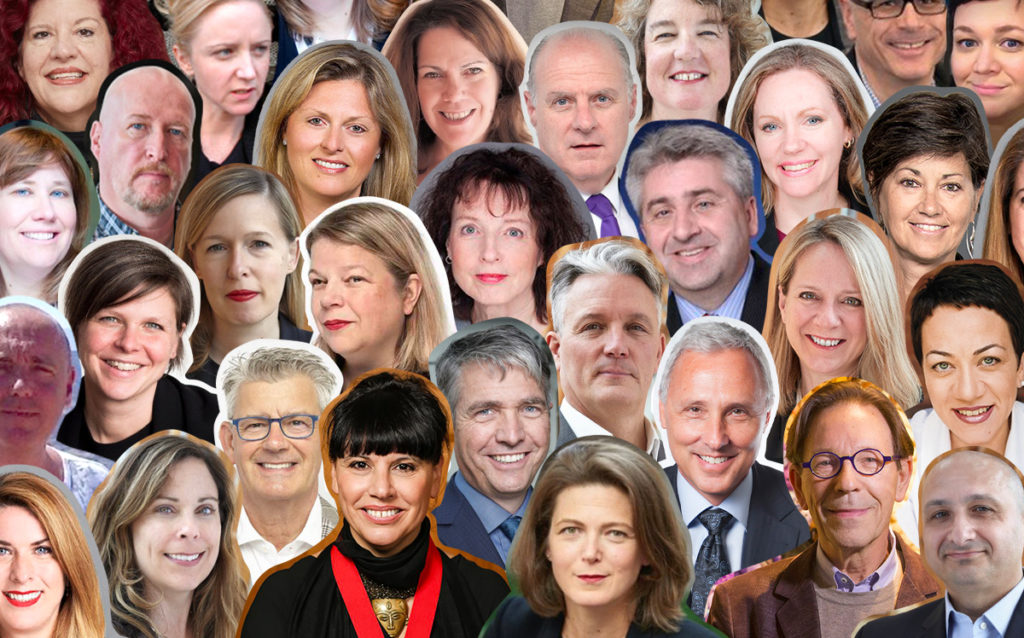 Image collage by Bridget Moser, showing directors and CEOs, board presidents and some senior executives from Canada’s four largest art museums, 2020.
Image collage by Bridget Moser, showing directors and CEOs, board presidents and some senior executives from Canada’s four largest art museums, 2020.
